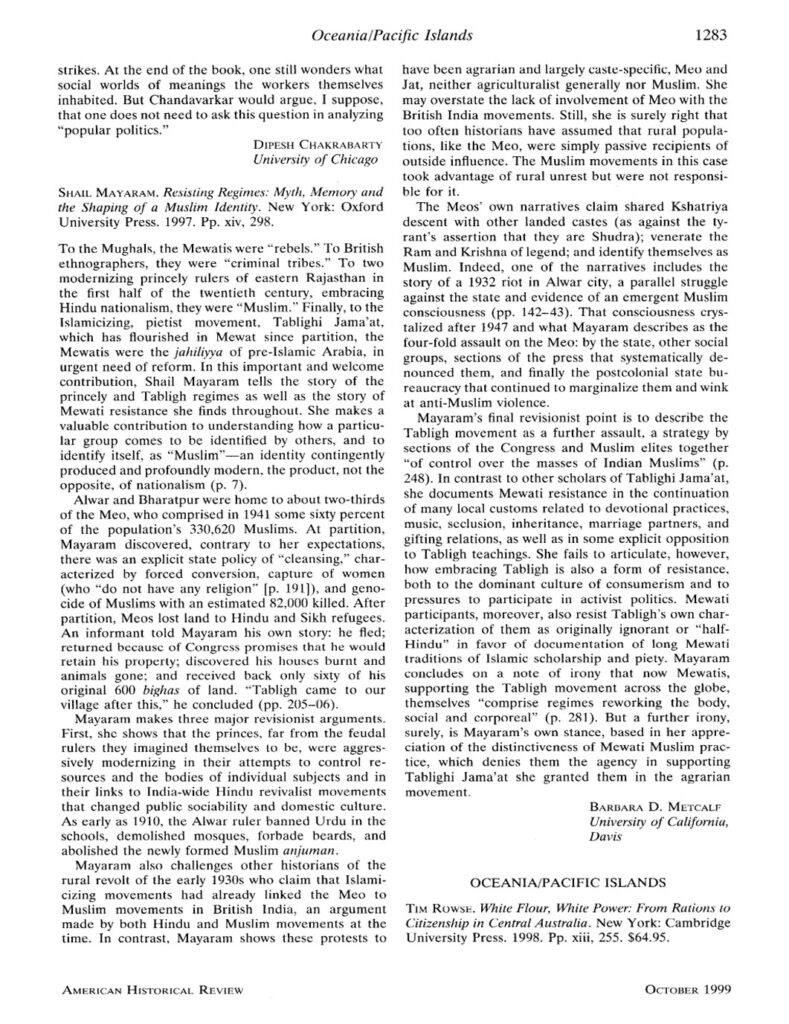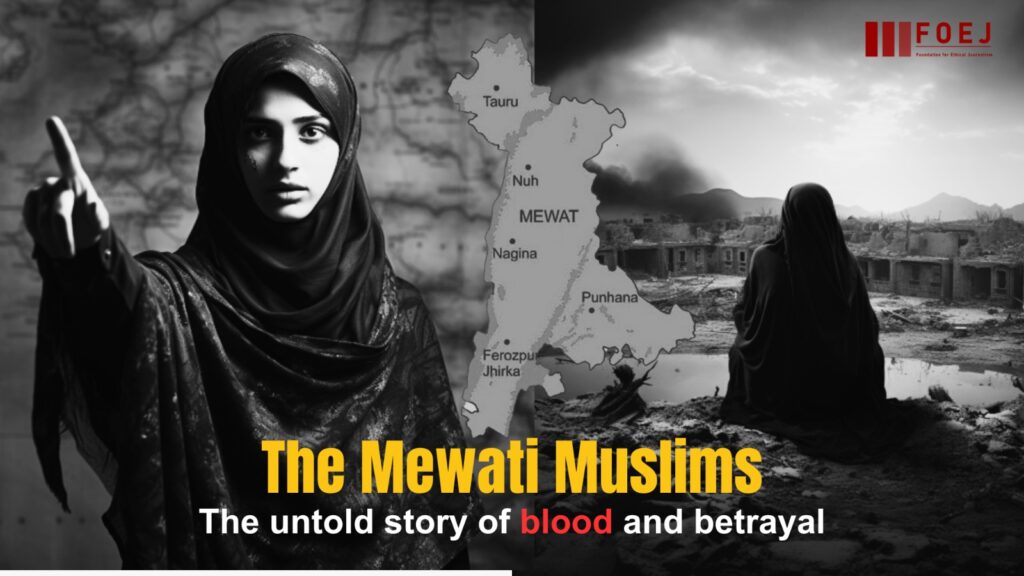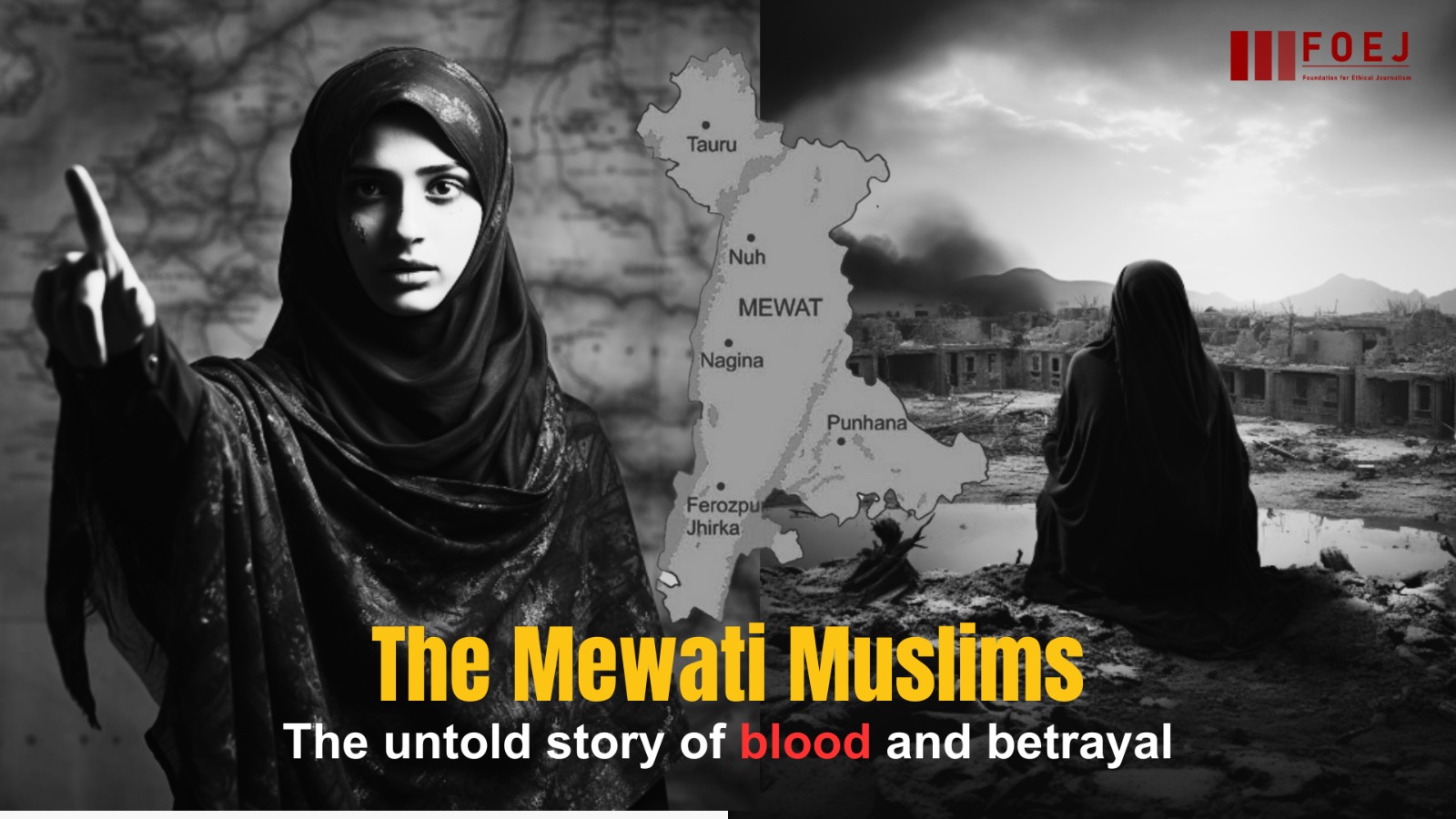hatehs
FULL MEMBER

- Joined
- Mar 10, 2023
- Messages
- 1,901
- Reaction score
- -2
- Country
- Location
foej.in > Blog > History > Muslims of Mewat: An untold history of Blood & Betrayal
HISTORY

Last updated: 2023/08/04 at 10:59 AM
Aasif Mujtaba
Share
9 Min Read
SHARE
The violence escalated like a forest fire and there were sporadic incidences across the state. In Anjuman Jama Masjid at sector 57 of Gurugram, the mob not only killed the Imam & critically injured other 2 devotees but also set the entire mosque on fire.
The killings on road or the feeling of dejection was not new to the Meos (Muslims of Mewat). They often talk about the way in which the entire community was marginalized on the sphere of education and political representation. They are also subjected to lynching across the state of Haryana & Rajasthan too. The Meo Muslims are dispersed across the former contiguous region of eastern Rajasthan, Uttar Pradesh, and Haryana. During India’s first war of independence in 1857, over 6,000 Meos made the ultimate sacrifice.
He also goes on adding “The women-if they were of marriageable age, were all taken. They were shuddh (pure) after drinking Ganga jal (water from the sacred river Ganges) and could be taken. Not a single Muslim was left in Alwar. Alwar was the first state to clear all the Muslims. Bharatpur followed”.
Remembering Partition, Cambridge University Press, Image: Aasif Mujtaba
 Shail Mayaram. Resisting Regimes: Myth, Memory and the Shaping of a Muslim Identity. New York: Oxford University Press. 1997. Pp. xiv, 298
Shail Mayaram. Resisting Regimes: Myth, Memory and the Shaping of a Muslim Identity. New York: Oxford University Press. 1997. Pp. xiv, 298
Under the pressure of the Alwar army, thousands of Meos were compelled to migrate to Pakistan. It is believed that the Maharaja was concerned about having a significant Muslim population in close proximity to the national capital. On December 19, 1947, Chaudhary Yasin Khan, a prominent Meo leader and a member of the Punjab Legislative Assembly, played a crucial role in inviting Gandhi to Ghasera, a village very near to Delhi. At that time, the village was hosting Muslim Meo refugees from Alwar and Bharatpur in Rajasthan who were on their way to Pakistan. During Gandhi’s visit, he successfully persuaded half of the refugees to stay back, and as a result, the village earned its unofficial name — Gandhi Gram Ghasera. Since then, the only school in the village, known as the Government Senior Secondary School, was established at the very location where Mahatma Gandhi addressed the people. Ghandhi also promised these people that the nature of the Indian State will be secular and they will also get proper freedom to practice and propagate their religion.
After nearly 75 years, the Meo people find themselves trapped in a recurring cycle of violence, propaganda, and betrayal. In 1947, instead of scrutinizing the communal motives behind the Maharaj of Alwar’s persecution of the Meos, people tended to focus on questioning the community’s retaliation to the violence. Similarly, in a recent incident, instead of questioning why Monu Manesar was not arrested despite his controversial social media posts about his travel, which understandably sparked anger, some are questioning the Meos for resisting the rally. The same pattern of avoiding the root cause and blaming the victims continues to afflict the Meo community.
References,
HISTORY
Muslims of Mewat: An untold history of Blood & Betrayal
Last updated: 2023/08/04 at 10:59 AM
Aasif Mujtaba
Share
9 Min Read
SHARE
The streets of Mewat witnessed a violent and chaotic afternoon, with numerous cars set on fire and multiple riot incidents. Tragically, five people lost their lives, and over 50 others sustained injuries during the unrest. The violence erupted when local Muslims protested against the presence of Monu Manesar during a rally. Monu is accused of kidnapping two Muslim youths, Nasir and Junaid, from Ghatmika village, torturing them, and setting them on fire inside their vehicle. The police reported that the religious procession named ‘Brij Mandal Jalabhishek Yatra,’ which was initiated by BJP district president Gargi Kakkar from Gurugram’s Civil Lines, was halted by a group of men near Khedla Mod in Nuh. The situation quickly escalated into a widespread riot, affecting multiple locations across Haryana. Muslims were aghast that police were giving a free hand to the goons who were carrying arms and ammunitions in their vehicle.One should rather die than be betrayed. There is no deceit in death. It delivers precisely what it has promised. Betrayal is the willful slaughter of hope.
― Steven Deitz
Contents
One should rather die than be betrayed. There is no deceit in death. It delivers precisely what it has promised. Betrayal is the willful slaughter of hope.Blood & BetrayalThe reported killings & mass rapes
FoEJ Media
The violence escalated like a forest fire and there were sporadic incidences across the state. In Anjuman Jama Masjid at sector 57 of Gurugram, the mob not only killed the Imam & critically injured other 2 devotees but also set the entire mosque on fire.
The killings on road or the feeling of dejection was not new to the Meos (Muslims of Mewat). They often talk about the way in which the entire community was marginalized on the sphere of education and political representation. They are also subjected to lynching across the state of Haryana & Rajasthan too. The Meo Muslims are dispersed across the former contiguous region of eastern Rajasthan, Uttar Pradesh, and Haryana. During India’s first war of independence in 1857, over 6,000 Meos made the ultimate sacrifice.
Blood & Betrayal
In 1947, there were a series of attacks and persecution of Meo Muslims across the region. From the account of a captain in the army of erstwhile Alwar state that was recorded by Shail Mayaram in 1993, it is clear that the Alwar army categorically killed thousands of Meo Muslims just to clear the area for the Hindu Refugees from Pakistan. In the words of the captain “I was the ADC to His Highness Tej Singh (the ruler of Alwar). It had been decided to clear the state of Muslims. The orders came from Sardar Patel. He spoke to His Highness on the hot line. The killings of Hindus at Noakhali and Punjab had to be avenged. All the Meos from Firozpur Jhirka down were to be cleared and sent to Pakistan, their lands taken over. [Because] the refugees from Pakistan were coming in. They told us all sorts of stories of what had been done to them. We did whatever was happening there, like parading women naked on the streets in Tijara and Naugaonwa after their families had been killed.” In Tijara, following an intense 18-hour battle between the troops of Maharaj of Alwar and a group of 10,000 Meo Muslims, he stated, “We defeated all of their forces, killing every single male combatant.”He also goes on adding “The women-if they were of marriageable age, were all taken. They were shuddh (pure) after drinking Ganga jal (water from the sacred river Ganges) and could be taken. Not a single Muslim was left in Alwar. Alwar was the first state to clear all the Muslims. Bharatpur followed”.
Remembering Partition, Cambridge University Press, Image: Aasif Mujtaba
The reported killings & mass rapes
Mayaram wrote in an article, “In 1947 the Meos are subject to one of the first exercises of ethnic cleansing. This is euphemistically (and literally) called safaya (to clean). Thirty thousand Meos are killed in the princely state of Bharatpur alone. And this is an official figure. No figures are available for the numbers killed and displaced in Alwar. But the total Meo population in the two princely states is nearly 200,000. Overnight, the Meos are slaughtered or evicted by multi-caste mobs referred to as dhars. Their villages are razed to the ground. Only those allowed to stay have been subject to shuddhi (so-called purification, in fact, a euphemism for a conversion rite). The violence is hardly spontaneous. It is completely organised by the princely states and orchestrated by the organisations of what are today referred to as the ‘Hindu Right’. Certain national level leaders belonging to the Congress are also among its supporters/participants.”Alwar and Bharatpur were home to about two-thirds of the Mewat, who comprised in 1941 some sixty percent of the population’s 330,620 Muslims. At partition, Mayaram discovered, contrary to her expectations, there was an explicit state policy of “cleansing,” characterized by forced conversion, capture of women and genocide of Muslims with an estimated 82,000 killed. After partition, Meos lost land to Hindu and Sikh refugees.
Under the pressure of the Alwar army, thousands of Meos were compelled to migrate to Pakistan. It is believed that the Maharaja was concerned about having a significant Muslim population in close proximity to the national capital. On December 19, 1947, Chaudhary Yasin Khan, a prominent Meo leader and a member of the Punjab Legislative Assembly, played a crucial role in inviting Gandhi to Ghasera, a village very near to Delhi. At that time, the village was hosting Muslim Meo refugees from Alwar and Bharatpur in Rajasthan who were on their way to Pakistan. During Gandhi’s visit, he successfully persuaded half of the refugees to stay back, and as a result, the village earned its unofficial name — Gandhi Gram Ghasera. Since then, the only school in the village, known as the Government Senior Secondary School, was established at the very location where Mahatma Gandhi addressed the people. Ghandhi also promised these people that the nature of the Indian State will be secular and they will also get proper freedom to practice and propagate their religion.
After nearly 75 years, the Meo people find themselves trapped in a recurring cycle of violence, propaganda, and betrayal. In 1947, instead of scrutinizing the communal motives behind the Maharaj of Alwar’s persecution of the Meos, people tended to focus on questioning the community’s retaliation to the violence. Similarly, in a recent incident, instead of questioning why Monu Manesar was not arrested despite his controversial social media posts about his travel, which understandably sparked anger, some are questioning the Meos for resisting the rally. The same pattern of avoiding the root cause and blaming the victims continues to afflict the Meo community.
References,
- Remembering Partition, Gyanendra Pandey, Cambridge University Press, 2001, P-196
- Shail Maryam. Resisting Regimes: Myth, Memory and the Shaping of a Muslim Identity. New York: Oxford University Press. 1997
- https://www.hindustantimes.com/static/Meo-Muslims-of-Mewat/
- https://scroll.in/article/911290/wh...emember-mahatma-gandhi-in-december-every-year


